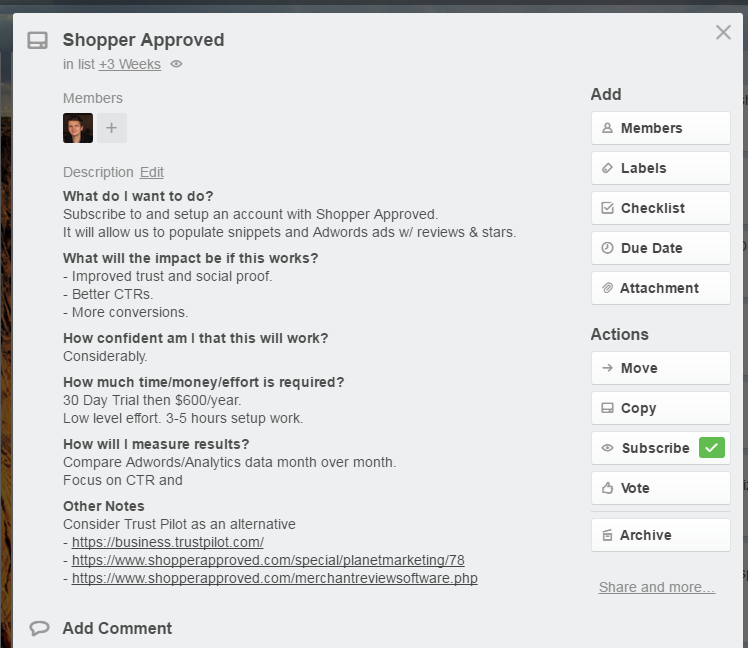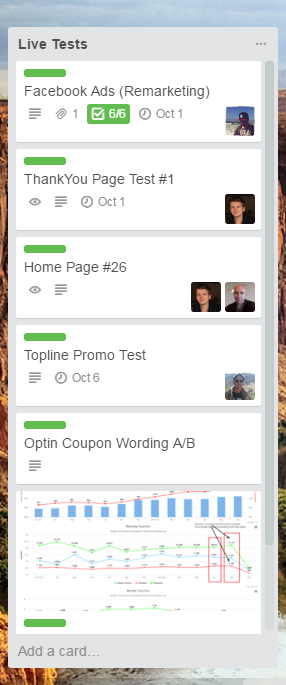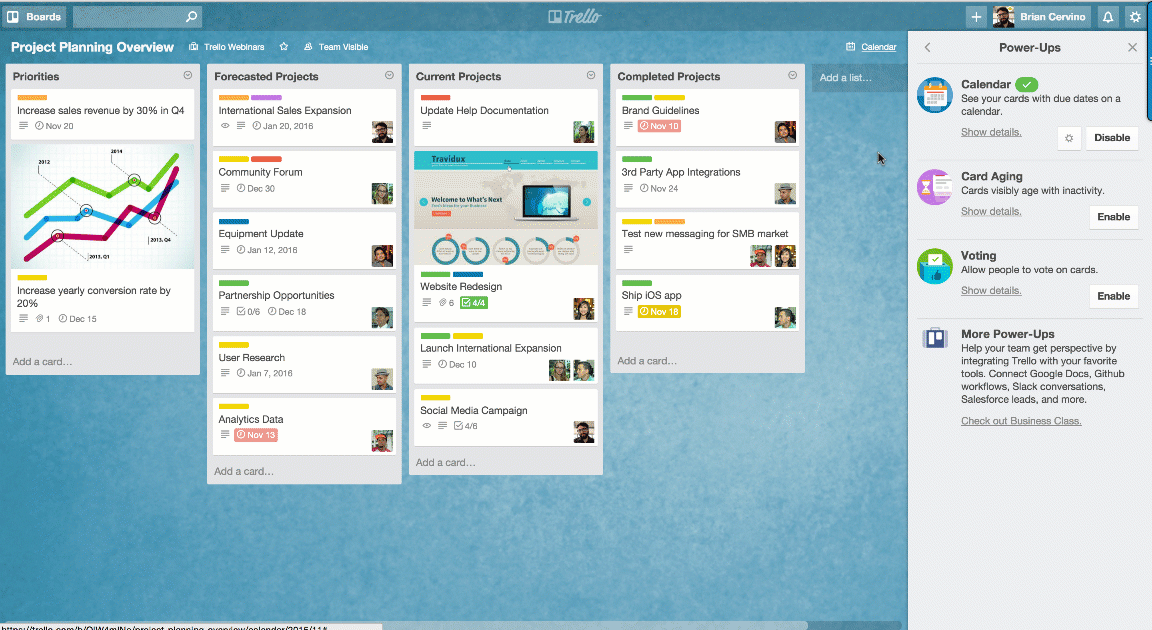Designing marketing experiments, monitoring their progress, and measuring results are all essential components to the success of any marketing campaign.
Far too often however, the methodology behind this process is either overlooked, disorganized or otherwise poorly managed. To be fair, it can be just a little bit complicated.
This isn’t helped by the fact that most marketing departments will be running multiple experiments simultaneously and across many different channels.
That means there won’t usually be one simple dashboard to view results, nor one tool to create and run the experiments themselves.
Have you or your marketing team struggled with this very problem?
If so, take a deep breath and relax. There’s a simple solution, and it doesn’t cost a fortune either.
In fact, follow my methods and you can track all of your marketing experiments from inception to completion without spending a dime.
All you need is Trello.
Trello? What’s Trello?
Only the best project management tool available.
Okay, I’m opinionated. So sue me. I’ve only become such a fanboy because Trello has changed my life both personally and professionally.
Sure there are other powerful tools out there. I’m not going to knock any of them or discourage you from trying them.
In fact, depending on your specific circumstances there may or may not be a better solution than Trello. After all, this is hardly a one-size-fits-all situation.
Nevertheless, the focus of this guide is how to use Trello to manage experiments specifically.
At its most basic level, Trello is a highly flexible tool that you can use to organize any manner of projects. But the simple and intuitive collaboration is what really makes it special and effective for us.
It’s particularly well-suited to planning, executing, and learning from marketing experiments. By using custom labels, a solid high-level structure, and “power ups,” you’ll be able to effectively manage complicated experiments from beginning to end.
Let’s take a look at what I mean by “high-level structure.”
Top-level organization

How you organize your board will depend on your team’s structure, your responsibility set, and what you want to accomplish. But I’ll share what works for my team.
I organize my team’s boards in “sprints,” unofficial Agile style. This helps keep us focused on top priorities week over week, and further allows me to give my bosses a quick and accessible view of what we’ve completed, what we’re working on, and where we’re headed.
You can hit the ground running by using Trello’s Sprint Template. Or you can use my own version of this approach. Here’s a quick glance at how it’s structured.
Moving cards from one week to the next is a simple drag and drop affair, and assigning labels and team members is a two-click process.
The takeaway is that Trello’s interface makes it really easy to stay nimble and keep the top level strategy in mind while you’re “in the weeds.”
“One card – one experiment”
If you checked out my sprint template above, you probably noticed that I like to keep a separate list for live experiments. I do this for a few reasons.
Primarily, it keeps them separate from tasks that are more accurately described as “check the box” activities.
Secondly, experiments need to be reevaluated later on. If you run into snags or start seeing lacking results, it’s important that you’re quickly able to access historical information about them.
That’s why I recommend what I call the “one card, one experiment” methodology. Each experiment gets its own card. This way it’s never confusing or difficult to find any given experiment.
I’d also recommend using simple and concise naming conventions for the cards individually. Trust me, it’s worth the extra few keystrokes.
By keeping experiments contained on their own cards, your interface will remain accessible, simple and team-friendly.
How does an experiment begin?
The inception of an experiment card should follow a set protocol that you and your team agree upon ahead of time. When team members start just throwing ideas out onto cards, your board can quickly become a jumbled mess.
Instead, I have team members “pitch” experiments that they think we should set up.
If one of our marketing team members wants to run an experiment (that isn’t just a website tweak or something simple), I have them use the following template that you’re more than welcome to copy:
- What do I want to do?
- What will the impact be if this works?
- How confident am I that this will work?
- How much time/money/effort is required?
- How will I measure results?

On an actual card, it should look something like this:
We find this method to be effective for a couple of pretty important reasons.
- It keeps us focused on objectives aimed at improving KPIs (key performance indicators).
- It encourages every team member to take responsibility.
- It demands that every project be properly researched and “defensible.”
- It helps us allocate budgets for every sprint, every month, etc.
Alternatively, you could use a completely different strategy for the organization of your experiments and still follow my methodology for tracking and measuring results.
To explore that possibility, take a look at Trello’s own “Growth Template.” You could use it on an entirely separate board to vet, discuss, and make determinations about what experiments to move forward with and when.
Tracking the experiments

So you’ve chosen the experiments you want to run and gone ahead and started some. Awesome!
Now you need to be able to monitor them in real-time to get an idea of how they’re performing.
This is where that “Live Experiments” list comes in handy. You can use it and its experiment cards to keep up to date and collaborate with teammates.
Maybe you want to make tweaks to an ad campaign. Maybe you want to kill an experiment. Maybe you just want to give your colleague a high-five for coming up with such a great idea. Either way, you can do all of this on the cards themselves.
I’d also recommend checking out a few of the “Power-Ups” as they can really make a difference.
Card aging power-up
I really love this power-up. It’s a very simple addition, but I find it extremely useful. It graphically “ages” cards when they haven’t received any updates in a while.
If you’re running dozens of experiments, it can often be hard to remember if you’ve checked in on all of them recently. Card aging makes this a breeze.
Pro tip: Use the “pirate” mode. Because it’s just better. Obviously.
Calendar power-up

Speaking of losing track of things…
Got 15 experiments running with various due dates? Having some trouble organizing which ones need your attention ASAP?
Using the calendar power-up you’ll be able to get a simple and clear view of all of your cards with due dates, laid out on a calendar.
Image Credit: Trello
Simple and just plain awesome.
Harvest power-up
If you have a distributed team, or just want to keep tabs on how long certain projects take, this is the powerup for you.
I like using this one for any “wildcard” projects I roll the dice on. Sometimes we’ll have an experiment that we want to give a go, but there’s concern that it may take more setup time than expected.
Using Harvest, you’ll be able to quickly assess if the project is going to work out. to see if this becomes a problem. If one of your team members logs 8 hours on a card but you wanted the project to take 5 hours tops, it might be time to revisit the scope and expected ROI of the experiment.
Measuring the results

The grand finale! The last leg of the journey! Last call!
You’ve made it. Let’s imagine one of your experiments is ready to be measured and analyzed.
Now all that’s left is to dive into the data and start analyzing. If you’re lucky, you’ll see some growth trending and can implement those changes for either permanent inclusion or further testing.
The job of the card is far from over however. For starters, I’d highly recommend posting your final thoughts and any conclusions you were able to draw from analyzing the data.
Side note: You can bold words in Trello by encapsulating them in **double asterisks**. You can also divide the main descriptive text using a line break followed by three dashes (shown below).
Take a few minutes to summarize your analysis. Attach screenshots. Use the GDrive power-up to share spreadsheets with teammates. You get the idea.
Last but not least, I like having an “Archived Test Results” list on my Trello board, where I keep completed experiment cards. You may decide you want to revisit an idea that failed before, or you may just want to be reminded of why you made a particular decision later on down the road.
For example: Two weeks after wrapping up an experiment, I might have a senior moment and find myself asking “why did I go with this particular landing page design?” Well, if I was rigorous with my documentation process I’ll be able to easily retrace my steps and see actual data on the experiment card.
I simply can’t tell you how many times this has saved me a lot of trouble.
That’s all there is to it folks. A simple and effective way to track and measure marketing experiments using Trello.
Do you have another method of tracking experiments? Do you have other Trello tips that help with projects like these? Looking forward to learning from your experiences in the comments below.






